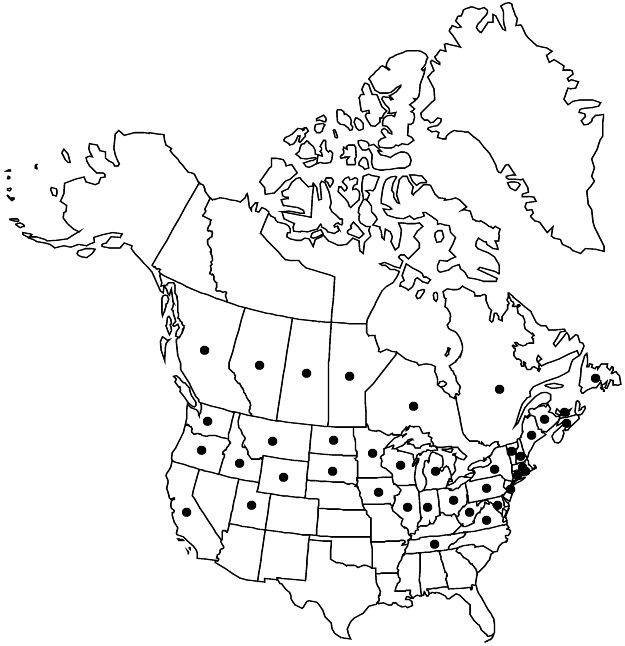Difference between revisions of "Rhamnus alnifolia"
Sert. Angl., 3. 1789.
FNA>Volume Importer |
FNA>Volume Importer |
||
| Line 28: | Line 28: | ||
|elevation=10–2700 m. | |elevation=10–2700 m. | ||
|distribution=Alta.;B.C.;Man.;N.B.;Nfld. and Labr. (Nfld.);N.S.;Ont.;P.E.I.;Que.;Sask.;Calif.;Conn.;Idaho;Ill.;Ind.;Iowa;Maine;Md.;Mass.;Mich.;Minn.;Mont.;N.H.;N.J.;N.Y.;N.Dak.;Ohio;Oreg.;Pa.;R.I.;S.Dak.;Tenn.;Utah;Vt.;Va.;Wash.;W.Va.;Wis.;Wyo. | |distribution=Alta.;B.C.;Man.;N.B.;Nfld. and Labr. (Nfld.);N.S.;Ont.;P.E.I.;Que.;Sask.;Calif.;Conn.;Idaho;Ill.;Ind.;Iowa;Maine;Md.;Mass.;Mich.;Minn.;Mont.;N.H.;N.J.;N.Y.;N.Dak.;Ohio;Oreg.;Pa.;R.I.;S.Dak.;Tenn.;Utah;Vt.;Va.;Wash.;W.Va.;Wis.;Wyo. | ||
| − | |discussion=<p>Rhamnus alnifolia is a primary host for the soybean aphid.</p> | + | |discussion=<p><i>Rhamnus alnifolia</i> is a primary host for the soybean aphid.</p> |
|tables= | |tables= | ||
|references= | |references= | ||
| Line 52: | Line 52: | ||
|publication year=1789 | |publication year=1789 | ||
|special status=Endemic | |special status=Endemic | ||
| − | |source xml=https://jpend@bitbucket.org/aafc-mbb/fna-data-curation.git/src/ | + | |source xml=https://jpend@bitbucket.org/aafc-mbb/fna-data-curation.git/src/8f726806613d60c220dc4493de13607dd3150896/coarse_grained_fna_xml/V12/V12_1105.xml |
|genus=Rhamnus | |genus=Rhamnus | ||
|species=Rhamnus alnifolia | |species=Rhamnus alnifolia | ||
Revision as of 14:43, 18 September 2019
Shrubs, 0.5–1(–1.5) m, unarmed. Branchlets gray to brown, glabrous or pubescent. Leaves deciduous, alternate; petiole 5–15 mm; blade dark green to olive green on both surfaces, lanceolate-oblong to elliptic or lanceolate-ovate, 4.5–11 cm, herbaceous, base cuneate to rounded, truncate, or subcordate, margins crenate to crenate-serrate, apex obtuse to acute or acuminate, abaxial surface glabrous or puberulent along veins, adaxial surface glabrous or glabrate; secondary veins (4–)5–7 pairs, all diverging at nearly same angle. Inflorescences fascicles or flowers solitary. Pedicels 2–10 mm. Sepals 5. Petals 0. Drupes black, globose or slightly elongate, 6–8 mm; stones 3.
Phenology: Flowering May–Jul.
Habitat: Fens and swamps, generally calcareous, riparian thickets, interdunal swales, shore lines, marshes and mats, wet meadow edges, outcrops, deciduous and coniferous forests.
Elevation: 10–2700 m.
Distribution

Alta., B.C., Man., N.B., Nfld. and Labr. (Nfld.), N.S., Ont., P.E.I., Que., Sask., Calif., Conn., Idaho, Ill., Ind., Iowa, Maine, Md., Mass., Mich., Minn., Mont., N.H., N.J., N.Y., N.Dak., Ohio, Oreg., Pa., R.I., S.Dak., Tenn., Utah, Vt., Va., Wash., W.Va., Wis., Wyo.
Discussion
Rhamnus alnifolia is a primary host for the soybean aphid.
Selected References
None.